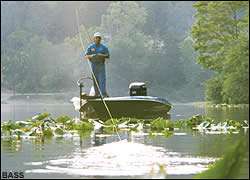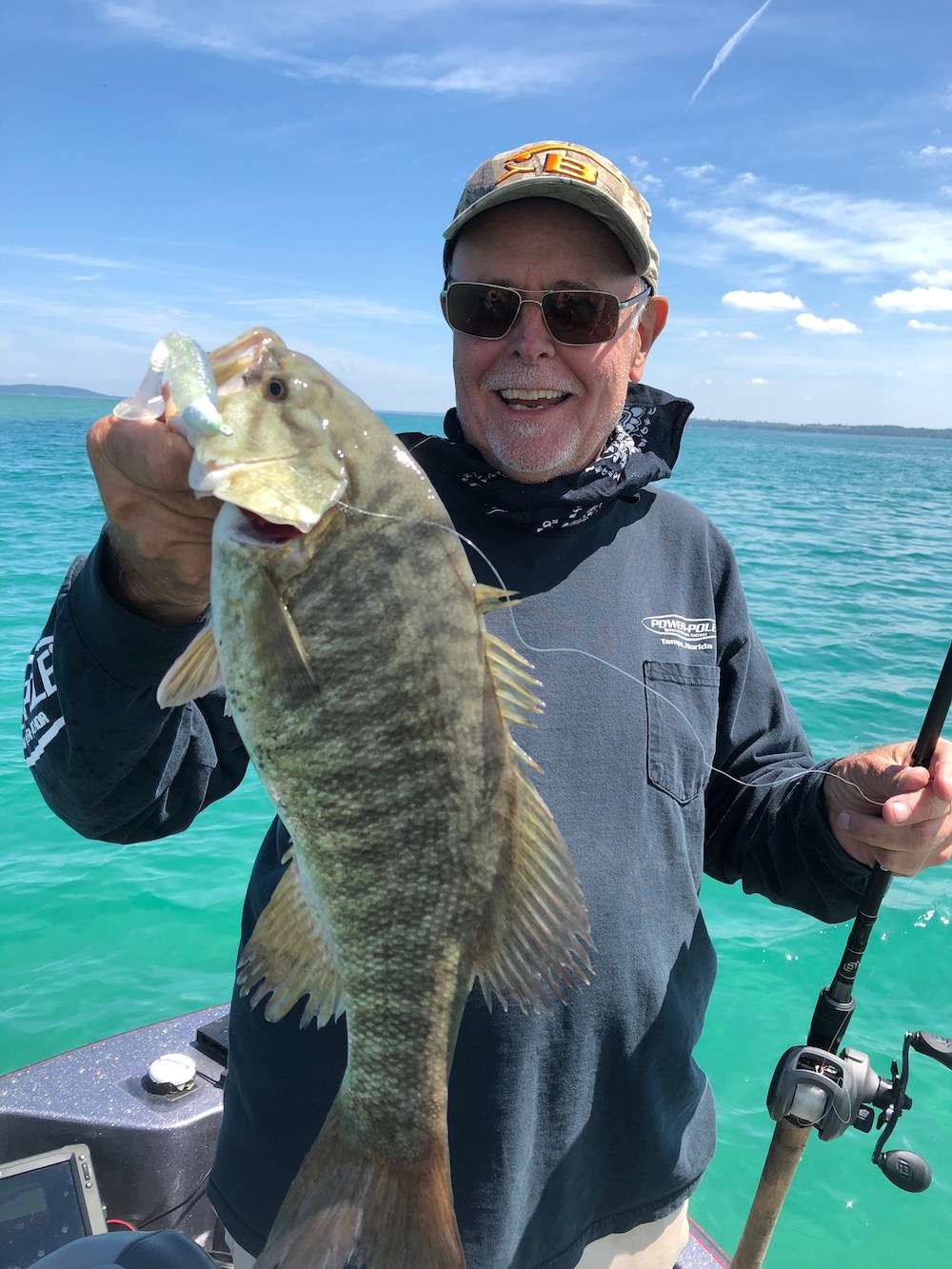
Aviolent topwater strike is unquestionably one of the supreme thrills in bass fishing. Of course, any bass taken on the surface is fun, but nothing can compare to that magic moment when a “great ol’ big ‘un” sucks in your topwater offering!
But is catching a lunker bass on top a totally random occurrence, or are there strategies you can employ to increase the size of your surface catch? We recently queried a Tennessee topwater expert on the topic of catching big bass on surface baits. If you’ve ever dreamed of having a monster bass explode on your Pop-R, Zara Spook or buzzbait, his input can help make it happen.
Fingernails on a blackboard
“A noisy topwater lure is like fingernails on a blackboard to a lunker bass,” believes Mt. Juliet, Tenn., angler Steve Dodson. “It has the potential of provoking an aggressive and immediate killing response more than any other lure style.”
Dodson, a computer programmer and veteran bass angler, has become adept at catching big bass on a variety of topwater styles in a wide array of venues. “I used to live in Illinois, where I fished small lakes and reclaimed strip mining pits. There, the ultimate thrill was catching a monster bass at night on a Jitterbug. Here in Tennessee, I fish both big reservoirs and small lakes. I’ve found topwater lures will catch big bass everywhere, as long as you adjust your bait, presentation and tackle to conditions.”
Topwaters are a great way to latch on to a huge bass in today’s highly pressured fishing environment, Dodson believes. “Today, most local anglers throw spinnerbaits, Carolina rigs and crankbaits, and ignore topwaters. This fact alone makes me want to fish ’em, since quality bass haven’t learned to avoid them.”
Many Bassmaster who do fish topwaters use them only in late summer and fall, when large numbers of bass school in open water and chase baitfish to the surface. But is this a good time to catch a big bass on top? “I’ve caught very few largemouth over 3 pounds in the jumps,” Dodson says. “Almost every largemouth over 5 pounds I’ve caught on top appeared to be a loner, not part of a school, and was close to cover. I’m not saying you’ll never see big largemouth schooling on top, but it’s rare. Catching bass in the jumps is fun, but if you’re like me, you’re more interested in hanging one big fish than a boatload of keepers.”
Smallmouth bass are a different story, Dodson claims. “I’ve seen entire schools of huge smallmouth busting shad on top over rockpiles and on points at Dale Hollow (Tenn.) and Pickwick (Ala.) reservoirs, and it’s truly an awesome sight. I once had two big smallies from a school hooked on my Zara Spook at the same time, but was only able to get one in — the other fish tore the back hook off.”
Dodson says his biggest topwater largemouth have come from isolated cover.
“Whenever I see that one little brushtop or lone stump 20 feet from any other piece of cover, I’ll plunk a topwater lure right on it,” he says, “provided the water temperature is 60 degrees or higher. I read recently in Bassmaster where BASS pro Charlie Ingram advised casting a surface bait right to isolated cover, instead of casting beyond the cover and then retrieving the lure past it. When I read that, I said, ‘Yes!!’ I’ve been doing the exact same thing for years, because that’s how you provoke a reaction strike from a big fish.
“If you cast 10 feet beyond the cover, the bass is on red alert by the time the lure reaches it. That’s when you get that tentative swirl or boil on the lure, rather than a solid strike.”
A few good baits
Dodson is particular about which topwater lures he uses in his quest for big bass. He listed the following as his proven lunker catchers (lures with contact information not listed are available at Bass Pro Shops, 800-BASS PRO):
Stickbait — “The Heddon Zara Spook is the gold standard in this category. It’s particularly effective on main lake structures like points and humps in deep, clear reservoirs, and is the best surface lure for trophy smallmouth. It’s not a particularly noisy bait, but it’s extremely erratic when retrieved in the classic walk-the-dog manner — this probably simulates a fleeing baitfish to bass. Big smallmouth will swim up 20 feet to plaster a yellow Spook.”
Buzzbait — “This is a good choice around shallow wood and thin grass cover, if the conditions are right. I catch my biggest fish on buzzers in choppy water, where most bassers don’t even use topwater baits. In calm water, usually thought of as buzzbait water, I catch smaller bass on it. Either white or black will work, and use a trailer hook. I don’t stay with a buzzbait long; if I don’t get bit on it pretty quickly, I’ll switch to another topwater style.”
Prop bait — “This is one of the noisiest surface styles; it needs to be used judiciously, or it’ll spook ’em. I like it on stormy days or when the water is murky. This is a lure you should definitely cast right to isolated cover instead of beyond it; it’s the ultimate reaction-strike bait. A buddy of mine recently caught an 11 ¾-pound largemouth on a blue Gilmore Jumper.” (Gilmore Mfg., 870-294-5337.)
Floating minnow — “A good topwater choice in postspawn, when big bass are hanging around shallow cover and not particularly aggressive. Just cast it around flooded bushes, twitch it once and let it sit — they’ll suck it in. It also works on unseasonably mild days in prespawn; I’ve caught big largemouth and smallmouth on minnow baits in 52 degree water. My favorite is the A.C. Shiner No. 450, bone with orange belly.” (A.C. Shiner, 513-738-1573.)
Jitterbug — “An awesome night surface lure. Cast it parallel to the shoreline or weed edges in farm ponds, strip pits or small natural lakes, and reel slowly and steadily. I like the magnum-sized Musky Jitterbug in black or frog; we used to wear out big bass on it at night in those Illinois strip pits. And if you think this is a big bait, there’s a guy in south Georgia who hand-carves an outrageous version of a Jitterbug that’s almost as big as a loaf of Wonder Bread; he’s caught 16-pounders on it at night!”
Popper — “A good bet when largemouth are in milfoil or hydrilla that doesn’t quite reach the surface. The Heddon Pop-R isn’t a big lure, but it’ll catch big fish. I also like the Viva Bug I popper — it’s not as loud as Pop-Rs, but it spits up a storm. Of course, the all-time lunker champ in this category has to be the Arbogast Hula Popper. When was the last time you threw one?” (Viva lures: Danny Joe’s Lures, 800-527-0918; www.dannyjoeslures.com.)
Scum frog — “The only realistic choice for fishing pond scum, lily pads and other high-coverage vegetation. Just crawl it across the slop, then when a fish blows up on it, wait ’til you feel it pull before setting the hook. You’ll catch bigger bass by probing way back into the thickest cover instead of taking the easy route and fishing the outside edges.”
Dodson’s favorite topwater rods are stiff 6-foot baitcasters retrofitted with pistol grips, a handle style he finds far more conducive to working these lures than the long handles currently in vogue. For smallmouth in clear reservoirs, he uses 14-pound Excel monofilament, but spools up with 30-pound Silver Thread when fishing prop baits, slop frogs and Jitterbugs around heavy cover for lunker largemouth. “Thirty-pound Silver Thread is the same diameter as many 15-pound monos,” he points out. “It’s superlimp and exceptionally abrasion-resistant, something to consider when gunning for big bass in brushy cover.” He’ll fish lighter topwater styles (Pop-Rs, A.C. Shiners) on a 6-foot spinning worm rod with 12-pound Excel.
More topwater insights
Dodson provided Bassmaster with more insights gleaned from three decades of successful big bass topwater fishing:
Although most of his big topwater largemouth were caught in shallow water, the majority were close to deeper water, such as a creek channel or ditch, when they struck. The Tennessee basser feels these superior fish may spend much of their time in the deeper areas, sliding up into the shallows only when hunting for food.
While most bassers think sunrise and sunset are prime topwater times, Dodson has caught some of his biggest bass on surface lures in the middle of the day. This includes both smallmouth chasing shad schools in open water, and largemouth parked on isolated cover. Bass associated with cover usually hold in the shade once the sun gets high.
Big topwater lures catch bigger bass — some of Dodson’s biggest largemouth were taken on the giant Musky Jitterbug. Lunker bass often feed infrequently and want a full-meal deal when they do feed. You can also fish bigger lures on heavier tackle and line, thereby increasing your odds of landing big fish.
Small waters — farm ponds, strip pits, private lakes — are great places to refine your topwater skills for lunker bass. These venues often have plenty of big fish in them, making it easier for you to determine which lures and presentations trigger strikes from quality bass.

